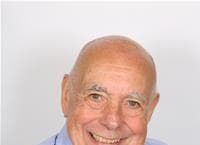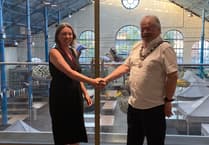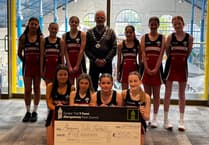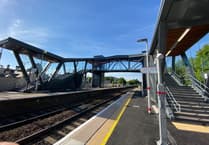SOME people are just 'plain-stupid' whilst other people are just 'plane-mad', and the aircraft enthusiasts who comprise the 'North Gwent Aviation Group' definitely fall into the latter category.
Formed over seven years ago by ex-RAF man and Gilwern resident Hywel Davies, the group which is now spearheaded by Abergavenny man Glyn Morgan specialise in digging up planes that were shot down and fell to earth during the Second World War.
Most recently the group unearthed a Heinkel He111H-5 over 30 feet beneath the earth at Weston Super-Mare, and the excavation was filmed for a forthcoming BBC documentary, entitled 'Dig 1940'.
The documentary which will be shown early next year, joins the North Gwent Aviation Group as they excavate planes that crashed to the ground during the Battle of France, the Battle of Britain, as well as the Heinkel He111H-5 - one of the planes that was shot down during the Blitz.
Plane enthusiast Glyn Morgan who has been locating planes for some 15 years now, became enraptured by the fantastic flying machines when he was just a young lad busy gluing together model airplane kits.
"Ever since I heard about the Spitfire that crashed on the Skirrid mountain on a training flight in 1942, I have been interested in the places that hold the remains of these planes," the committed wreckage finder told the Chronicle.
"Most weekends, the group and I are out searching sites throughout Britain hoping to strike lucky and unearth what to us is the equivalent of buried treasure."
As you can imagine, locating something that has been hidden away, deep down beneath our feet for nigh on 70 years presents its own set of unique problems.
However, with a wealth of experience under their belts when it comes to pinpointing the wreckage of war, the North Gwent Aviation Group have honed the practice of targeting grounded aircraft to such a fine art that it's almost, but not quite, like 'plane-sailing' to them now.
Glyn explained, "As the years pass, it's becoming more and more difficult to trace the crash sites, because of the shortage of reliable witnesses to identify the exact area of where the plane went down.
"However, our starting point has always been the RAF crash records which we take as our initial foundation and work from that. We then try and look for local witnesses and talk to them about what they know.
"Of course, because many of the crash sites are on farmland, we have to work in conjunction with the landowners, and there is only a certain window available to us during the year when the crops have been taken off the ground and we can dig.
"We also have to deal with the Military of Defence, as we require a special license to undertake our excavations. Fairplay to the MOD though, they have always been really helpful and never hindered us in our activities."
Glyn added with a smile, "The only downside is that officially all the wreckage belongs to the RAF and ends up in a museum, but we are always allowed to share a few bits and pieces amongst ourselves. In fact, after all these years I now have quite a collection of aircraft artifacts from that period, some of which I wasn't even involved with excavating myself, but have bought off fellow collectors."
In all his years of searching for the planes that haven't took to the skies in decades, Glyn recalls one dig that the North Gwent Aviation Group had particular problems with, "The plane in question was a Thunderbolt and it took two or three years to find, because it was in the middle of a wood, but no matter how long the search takes, it's always worth it when you bring the remains out of the ground."
Following on from the excavation of the Heinkel He111H-5, the North Gwent Aviation Group have a considerable number of other projects to get stuck into. Not least the digging up of a Hurricane in Dorset that was shot down during the Battle of Britain - a dig which will also be filmed for the forthcoming BBC documentary.
"The involvement with the BBC initially came about because they were looking to make a programme to coincide with the anniversary of the Battle of Britain," revealed Glyn.
"So they contacted us and asked if we wanted to be involved in digging up some heavy wreckage. Naturally we jumped at the chance, and now after having already dug up the plane that covers the 'Blitz' aspect of the programme, we'll shortly be turning our attention to the Battle of Britain.
"That's where the dig for the Hurricane comes in, and it will be especially interesting, because of the fact that it is underwater.
"But that's what great about what we do, every plane has a story tell and each one is completely unique."
The Heinkel He111H-5 dig which was attended by Glyn Morgan, Philip Catley, Ian and Phillipa Hodgkiss, Gareth Jones and Steve Vissard, was also notable in that the son of the pilot who shot down the plane was also present.
The Heinkel He111H-5 provided the Luftwaffe with a fast, manoeuvrable medium bomber which it used as a spearhead for the Blitzkrieg tactics so successfully employed during the early campaigns of the Second World War.
The Heinkel in question was shot down on April 4, 1941 at 22:25 hours by Flying Officer Edward D. Crew and Sergeant Norman Guthrie (Operator) in a Beaufighter from 604 squadron.
The intended target of the bomber was Avonmouth Docks, but the aircraft was destroyed by night-fighter action and dived vertically into the ground.
Only three out of the five members of the crew survived. Three bailed out, one fell from the aircraft and one was killed in the wreck.
Only a few bits of broken machine guns and a few bits of armour were found, with the engines and most of the air-frame burnt or buried.
That is until recently, thanks to the work of the North Gwent Aviation Group.



